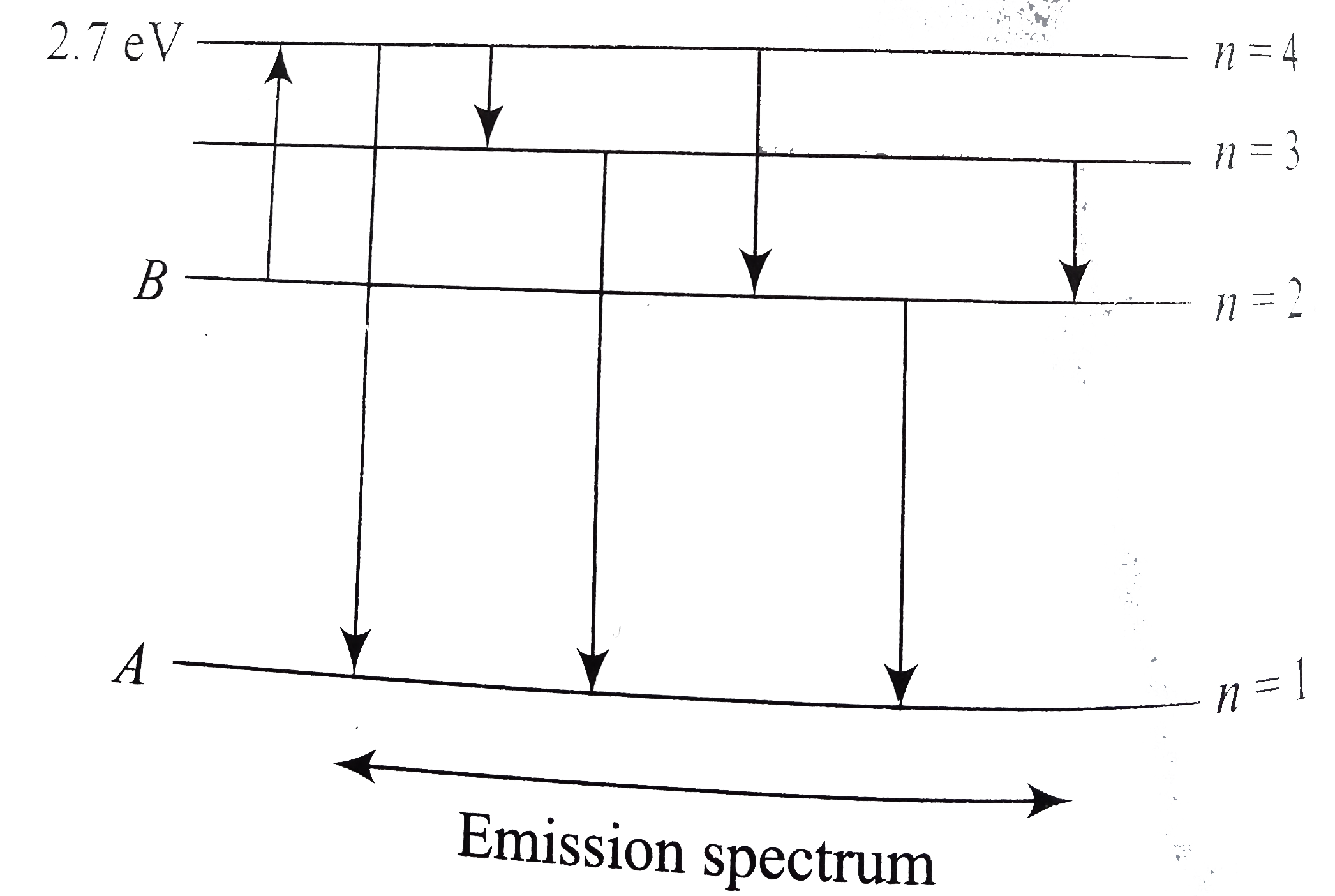A gas of identical hydrogen-like atoms has some atoms in the lowest in lower (ground) energy level A and some atoms in a partical upper (excited) energy level B and there are no atoms in any other energy level.The atoms of the gas make transition to higher energy level by absorbing monochromatic light of photon energy 2.7eV.
Subsequenty , the atom emit radiation of only six different photon energies. Some of the emitted photons have energy 2.7eV some have energy more , and some have less than 2.7eV.
a Find the principal quantum number of the intially excited level B
b Find the ionization energy for the gas atoms.
c Find the maximum and the minimum energies of the emitted photons.
The energy level of identical hydrogen-like atom are given by
En=−Bn2,B being a constant.
a. When a hydrogen-like atom absorbs energy 2.7eV This is only possible if transion of electron is from state B to any higher energy state. Six radiations are emitted only ?If the final state is n=4.
The energy of emitted radition is also more than 2.7eV, therefore , initial state connot be n=3. Hence , the only possibility is that initially state B has n=2. 
That is the principal quantum number of initially excited state B is n=2
b. Given E4−E2=2.7eV
∴−B42−(−B22)=2.7eV
Therefore , this gives B=14.4eV
the transition of electron should be from ground state (n=1) to n=∞.
Lonization energy of identical hydrogen-like gas atoms
ΔE=E1=−B∞2−(−B12)
c. Maximum energy of emitted photon is obtained when transition of electron is from n=4 to n=1.
∴Emax=−B42−(−B12)
Maximum energy of emitted photon is obtained when transition of electron is from n=4→n=3.
i.e. ,Emax=B(132−142)=14.4(19−116)=0.4eV
Topper's Solved these Questions
- ATOMIC PHYSICSBOOK - CENGAGE PHYSICS ENGLISHCHAPTER - ATOMIC PHYSICSEXERCISE - Exercise 4.1
15 Videos
- ATOMIC PHYSICSBOOK - CENGAGE PHYSICS ENGLISHCHAPTER - ATOMIC PHYSICSEXERCISE - Exercise 4.2
12 Videos
- ATOMIC PHYSICSBOOK - CENGAGE PHYSICS ENGLISHCHAPTER - ATOMIC PHYSICSEXERCISE - ddp.4.3
15 Videos
- ALTERNATING CURRENTBOOK - CENGAGE PHYSICS ENGLISHCHAPTER - ALTERNATING CURRENTEXERCISE - Single Correct
10 Videos
- CAPACITOR AND CAPACITANCEBOOK - CENGAGE PHYSICS ENGLISHCHAPTER - CAPACITOR AND CAPACITANCEEXERCISE - Integer
5 Videos
Similar Questions
Find the excitation energy of n = 3 level of He atom
View SolutionIn a sample of hydrogen atoms, all the atoms exist in two energy levels A and B. A is the ground level and B is some higher energy level. These atoms absorb photons of energy 2.7 eV and attain a higher energy level C.After this, these atoms emit photons of six different energies. Some of these photon energies are higher than 2.7 eV, some equal to 2.7 eV and some are loss than 2.7 eV.
The principal quantum number corresponding to energy level B is
View Solution
Knowledge Check
The total number of atomic orbitals in fourth energy level of an atom is
A16B32C4D8
In a sample of hydrogen atoms, all the atoms exist in two energy levels A and B. A is the ground level and B is some higher energy level. These atoms absorb photons of energy 2.7 eV and attain a higher energy level C.After this, these atoms emit photons of six different energies. Some of these photon energies are higher than 2.7 eV, some equal to 2.7 eV and some are loss than 2.7 eV.
The principal quantum number corresponding to energy level C is
View SolutionIn a sample of hydrogen atoms, all the atoms exist in two energy levels A and B. A is the ground level and B is some higher energy level. These atoms absorb photons of energy 2.7 eV and attain a higher energy level C.After this, these atoms emit photons of six different energies. Some of these photon energies are higher than 2.7 eV, some equal to 2.7 eV and some are loss than 2.7 eV.
The atomic number of these atoms is
View SolutionIn a sample of hydrogen atoms, all the atoms exist in two energy levels A and B. A is the ground level and B is some higher energy level. These atoms absorb photons of energy 2.7 eV and attain a higher energy level C.After this, these atoms emit photons of six different energies. Some of these photon energies are higher than 2.7 eV, some equal to 2.7 eV and some are loss than 2.7 eV.
The longest wavelength emitted in the radiation spectrum observed is
View SolutionThe electron of H-atom in the ground state is excited to a higher energy level by monuchromatic light of energy 13.22eV How many different photon are emitted when it return to the ground state?
View SolutionThe total number of subshells in fouth energy level of an atom is
View SolutionIn hydrogen atom, the order of energies of sub-shell of third energy level is ……….
View SolutionThe total number of atomic orbitals in fourth energy level of an atom is.
View Solution
